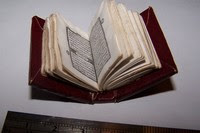So many rag rugs are rectangular that it is good to have a design for a different shape. This rug looks most effective on a light pine floor in a modern room.

107 cm (42 in) in diameter
Material and Equipment
- Drawing paper
- Coloured pencils
- Thick felt-tip pen
- Ruler
- Ball of string
- Scissors
- 127 x 127 cm (50 x 50 in) hessian/burlap
- Drawing pin
- Thin card
- Frame with dowelling
- Dressmaker’s pins
- Sewing machine
- Hook
- Assortment of material
- 127 x 127 cm (50 x 50 in) hessian for backing
- Latex/PVA glue
 For this rug, sketch the design on drawing paper to size and colour it to act as a guide for hooking the materials. To create a rough circle shape, mark the centre of the design with a felt-tip pen, then measure the distance from the centre to the edge with string, allowing a little extra to make a loop to tie round the pen.
For this rug, sketch the design on drawing paper to size and colour it to act as a guide for hooking the materials. To create a rough circle shape, mark the centre of the design with a felt-tip pen, then measure the distance from the centre to the edge with string, allowing a little extra to make a loop to tie round the pen.
 Cut the string and make a loose knot at the opposite end to the pen. Lay the hessian on a protected surface. Place a drawing pin in the knot of the string and press into the centre of the hessian. Tie the other end to the felt-tip pen and then draw a circle carefully as if using a compass
Cut the string and make a loose knot at the opposite end to the pen. Lay the hessian on a protected surface. Place a drawing pin in the knot of the string and press into the centre of the hessian. Tie the other end to the felt-tip pen and then draw a circle carefully as if using a compass
 Using the same technique, draw another circle about 15 cm ( 6 in) inside the previous one to mark the border. Trace and cut out the main shapes of the start-burst design in thin card, place them on the hessian and trace around them with a felt-tip pen.
Using the same technique, draw another circle about 15 cm ( 6 in) inside the previous one to mark the border. Trace and cut out the main shapes of the start-burst design in thin card, place them on the hessian and trace around them with a felt-tip pen.
 This rug is worked on a frame which uses dowelling to secure two of its edges. To make a channel to run the dowelling through, turn down the hessian on two sides (top and bottom if the design is rectangular), pin and machine across. Assemble the frame.
This rug is worked on a frame which uses dowelling to secure two of its edges. To make a channel to run the dowelling through, turn down the hessian on two sides (top and bottom if the design is rectangular), pin and machine across. Assemble the frame. Using scissors, cut up some of your materials into strips about 1 cm (0.5 in) wide, ensuring they are always on the straight, never on the bias. Commence hooking from the centre outwards.
Using scissors, cut up some of your materials into strips about 1 cm (0.5 in) wide, ensuring they are always on the straight, never on the bias. Commence hooking from the centre outwards.
 Shear the loops by cutting across them as if you were cutting a lawn. It is good idea to alternate shearing and hooking as you go.
Shear the loops by cutting across them as if you were cutting a lawn. It is good idea to alternate shearing and hooking as you go.
 This shows the final loop being put in place.
This shows the final loop being put in place.
Remove the rug from the frame and lay face-down on a table. Place the piece of backing material on top of the rug. Feeling the shape with your felt-tip pen, draw around the rug. Cut out the shape in the backing material, the same size as the finished rug.
Lay the backing on to the latexed back and press it with a hot iron
Apply latex to the cut edges and press them down firmly, slightly overlapping, as shown. Allow to dry.




















































